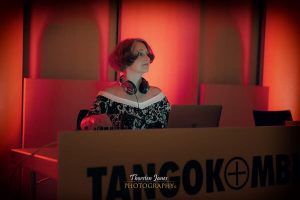DJ
I have been djing (and greatly enjoying it) since 2004. My activities began in the local Milongas of my home region. From 2006 on, I have been invited to dj during my travels as a tango teacher and at international Festivals, Encuentros and Festivalitos. I also give dj-seminars in which I explain the role of a traditional tango-DJ, how to build up tandas and whole sets as well as how to create a harmonious flow of music for social dancers.

Traditional setup
I arrange the music in tandas with cortinas and in a fixed sequence of tangos, milongas and valses. Usually this is TTMTTV, with 4 tangos and 3 milongas/valses per tanda. I will use classic tango music, mostly from the 30s and 40s of the last century with excursions into the late 20s or 50s.
Very rarely I might play a tanda by a contemporary tango band or an old non-argentinian tango orchestra. But this has to fit to the occasion. An example: I once played a „last tanda“ with Carlo-Buti-tangos at a local Milonga in Italy, but I would not use these songs at an international Encuentro or in Norway. I will not play electro tango, tango canciónes, non-tango, Piazzolla or stage dance orchestras like the Forever Tango Orchestra. I also don’t play salsa or chacarera, but I am up for some disco music after the milonga.
My style
I am constantly striving for the perfect harmony of rhythmical and lyrical tandas, spiced with an appropriate amount of drama. These three main styles have to blend amicably into each other without creating harsh contrasts. There must nevertheless be diversity to assure that the different moods and personalities of the dancers at an event will be reflected.
So many wonderful tracks have been recorded in the years 1927 – 1960, that a milonga is much too short to present even a fraction of them. Since every orchestra has it’s distinctive style, it will never get boring or monotonous. I am a huge fan of Di Sarli and Biagi, so there will never be a Milonga without those two. But all the other important orchestras (D’Arienzo, Troilo, Fresedo, Calo, Canaro, Pugliese, Rodriguez…) will of course also receive adequate attention to guarantee that everyone has fun. The happy faces of the dancers attest to the success of my method.
On „hits“
The better we know and love a tango, the better we will dance to it. I will therefore always give enough space to the evergreens. In the same time, the choice of a dj cannot become too predictable and once in a while, a new tango should be introduced to the audience.
Danceability is my primary concern
Theoretically it is possible to dance to anything, but not every music is equally suited for the social dance floor. Features like speed, audibility of a constant beat, complexity of layers, predictability of the melody and usage of irregular patterns play a role in choosing the songs and depend on the general dance level of the audience. Therefore the music for a beginners-practica has to be different than the choice for an encuentro milonguero.
To give an example: I will not play a tanda of Pugliese at a beginner’s Milonga, but most likely at an Encuentro with an advanced level of dancing. And even on such an occasion, I might not choose Malandraca or Negracha, because I believe them to be too complex and expressive for the social dance floor. Other recordings by Pugliese, e.g. from the 40s or tangos like Farol or La Tupungatina are much better suited for a Milonga.
Read more
Those who want to know more about my method might want to read this article which I wrote in 2006 for the German tango magazine Tangodanza or an interview by the Italian DJ Supersabino.
For further information and prices, please contact me.